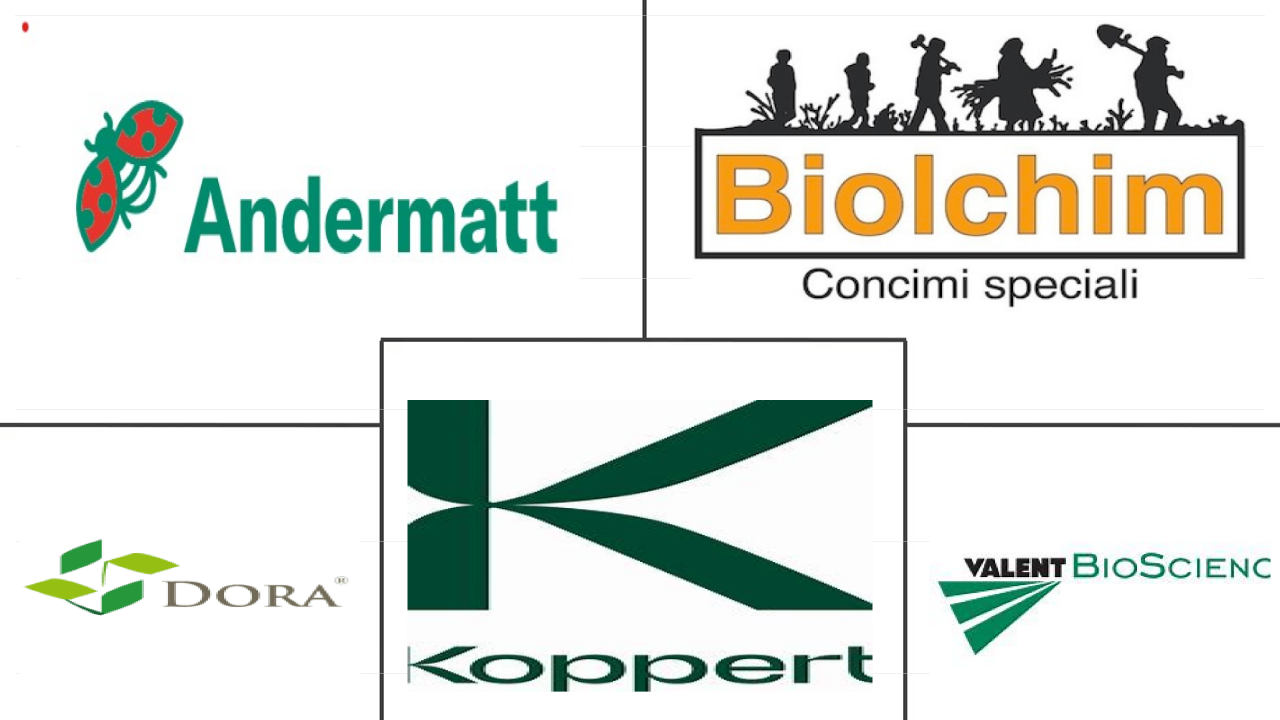Market Size of china biopesticides Industry
| Icons | Lable | Value |
|---|---|---|
|
|
Study Period | 2017 - 2029 |
|
|
Market Size (2024) | USD 292.85 Million |
|
|
Market Size (2029) | USD 477.70 Million |
|
|
Largest Share by Form | Biofungicides |
|
|
CAGR (2024 - 2029) | 10.28 % |
|
|
Fastest Growing by Form | Bioinsecticides |
|
|
Market Concentration | Low |
Major Players |
||

|
||
|
*Disclaimer: Major Players sorted in no particular order |
China Biopesticides Market Analysis
The China Biopesticides Market size is estimated at 292.85 million USD in 2024, and is expected to reach 477.70 million USD by 2029, growing at a CAGR of 10.28% during the forecast period (2024-2029).
292.85 Million
Market Size in 2024 (USD)
477.70 Million
Market Size in 2029 (USD)
2.37 %
CAGR (2017-2023)
10.28 %
CAGR (2024-2029)
Largest by Form
42.20 %
value share, Biofungicides, 2023
Bio fungicides is a formulation applied to control the activity of plant pathogenic fungi that cause plant diseases. Bio fungicides may be of microbial or botanical origin.
Fastest by Form
10.64 %
Projected CAGR, Bioinsecticides, 2024-2029
The bacterial insecticide Bacillus Thuringiensis is widely used bioinsecticide due to its potential to control pests by generating proteins during the sporulation phase.
Largest by Crop Type
82.24 %
value share, Row Crops, 2023
Row crops accounted for 82.3% of the biopesticides market in China. Of all biopesticide categories, row crops utilize the most biofungicides. This is due to their efficient management of plant diseases.
Fastest by Crop Type
10.69 %
Projected CAGR, Cash Crops, 2024-2029
The major cash crops grown in China include sugarcane, tea, cotton, tobacco, etc. Biofungicides are the most consumed biopesticides in cash crops with 42.3% in 2022.
Leading Market Player
0.52 %
market share, Valent Biosciences LLC, 2022

Valent BioSciences specializes in environmentally friendly, biological solutions for modern farming. It helps in prevention of the harmful insects and nematodes.
- Biopesticides are naturally occurring substances or agents derived from animals, plants, insects, and microorganisms, including bacteria and fungi, used to manage agricultural pests and infections. In 2022, Chinese biopesticides accounted for about 47.1% of the entire crop protection market value.
- In the Chinese biopesticides market, biofungicide was the most consumed biopesticide, dominating the market with a volume share of 55.0%, followed by bioinsecticides, other biopesticides, and bioherbicides, with market shares of 31.0%, 11.5%, 2.4%, respectively, in 2022.
- Row crop cultivation is dominant in the country, and its biopesticides consumption was valued at about USD 204.7 million in 2022. This is due to the large area under cultivation of field crops, which are considered the country's staple food.
- Microbial pesticides are pesticides that contain live organisms as active components, such as bacteria, fungi, viruses, protozoa, or microorganisms that have undergone genetic modification. Bacillus thuringiensis, Bacillus subtilis, Helicoverpa armigera nuclear polyhedrosis virus, Metarhizium anisopliae, and Paenibacillus polymyxa are the top five microbial pesticides in China in terms of manufacturing output.
- Botanical pesticides are pesticides with active components extracted directly from plants. The currently registered botanical pesticides include matrine, rotenone, azadirachtin, veratramine, and pyrethrin.
- Organic farming also expands in China as the demand for organic food rises. From 2017 to 2022, 29.6% of organic acreage increased. Increasing organic acreage and government initiatives are expected to increase the market value of biopesticides during the forecast period, with a projected CAGR of 9.1%.
China Biopesticides Industry Segmentation
Biofungicides, Bioherbicides, Bioinsecticides are covered as segments by Form. Cash Crops, Horticultural Crops, Row Crops are covered as segments by Crop Type.
- Biopesticides are naturally occurring substances or agents derived from animals, plants, insects, and microorganisms, including bacteria and fungi, used to manage agricultural pests and infections. In 2022, Chinese biopesticides accounted for about 47.1% of the entire crop protection market value.
- In the Chinese biopesticides market, biofungicide was the most consumed biopesticide, dominating the market with a volume share of 55.0%, followed by bioinsecticides, other biopesticides, and bioherbicides, with market shares of 31.0%, 11.5%, 2.4%, respectively, in 2022.
- Row crop cultivation is dominant in the country, and its biopesticides consumption was valued at about USD 204.7 million in 2022. This is due to the large area under cultivation of field crops, which are considered the country's staple food.
- Microbial pesticides are pesticides that contain live organisms as active components, such as bacteria, fungi, viruses, protozoa, or microorganisms that have undergone genetic modification. Bacillus thuringiensis, Bacillus subtilis, Helicoverpa armigera nuclear polyhedrosis virus, Metarhizium anisopliae, and Paenibacillus polymyxa are the top five microbial pesticides in China in terms of manufacturing output.
- Botanical pesticides are pesticides with active components extracted directly from plants. The currently registered botanical pesticides include matrine, rotenone, azadirachtin, veratramine, and pyrethrin.
- Organic farming also expands in China as the demand for organic food rises. From 2017 to 2022, 29.6% of organic acreage increased. Increasing organic acreage and government initiatives are expected to increase the market value of biopesticides during the forecast period, with a projected CAGR of 9.1%.
| Form | |
| Biofungicides | |
| Bioherbicides | |
| Bioinsecticides | |
| Other Biopesticides |
| Crop Type | |
| Cash Crops | |
| Horticultural Crops | |
| Row Crops |
China Biopesticides Market Size Summary
The China biopesticides market is experiencing significant growth, driven by the increasing demand for sustainable agricultural practices and organic food production. Biopesticides, derived from natural sources such as plants, animals, and microorganisms, are gaining traction as a viable alternative to synthetic pesticides. This shift is largely due to the rising concerns over soil toxicity and the overuse of chemical fertilizers, which have prompted a move towards more environmentally friendly farming methods. The market is characterized by a diverse range of products, including biofungicides, bioinsecticides, and botanical pesticides, with biofungicides being the most widely used. The expansion of organic farming in China, supported by government initiatives and a growing middle class with heightened health awareness, is further propelling the demand for biopesticides.
The market landscape is fragmented, with several key players such as Andermatt Group AG, Biolchim SPA, and Koppert Biological Systems Inc. actively participating in the sector. Despite the high cost of organic produce, there is a strong willingness among affluent consumers to invest in organic foods, driven by concerns over health and food safety. The Chinese government is also promoting organic agriculture as part of its broader strategy to enhance food security and reduce reliance on chemical inputs. As a result, the biopesticides market is poised for substantial growth, with projections indicating a steady increase in market size over the coming years. The focus on organic food production not only caters to domestic demand but also positions China as a significant player in the global organic market, with potential for increased exports to regions such as Europe and North America.
China Biopesticides Market Size - Table of Contents
-
1. MARKET SEGMENTATION (includes market size in Value in USD and Volume, Forecasts up to 2029 and analysis of growth prospects)
-
1.1 Form
-
1.1.1 Biofungicides
-
1.1.2 Bioherbicides
-
1.1.3 Bioinsecticides
-
1.1.4 Other Biopesticides
-
-
1.2 Crop Type
-
1.2.1 Cash Crops
-
1.2.2 Horticultural Crops
-
1.2.3 Row Crops
-
-
China Biopesticides Market Size FAQs
How big is the China Biopesticides Market?
The China Biopesticides Market size is expected to reach USD 292.85 million in 2024 and grow at a CAGR of 10.28% to reach USD 477.70 million by 2029.
What is the current China Biopesticides Market size?
In 2024, the China Biopesticides Market size is expected to reach USD 292.85 million.

